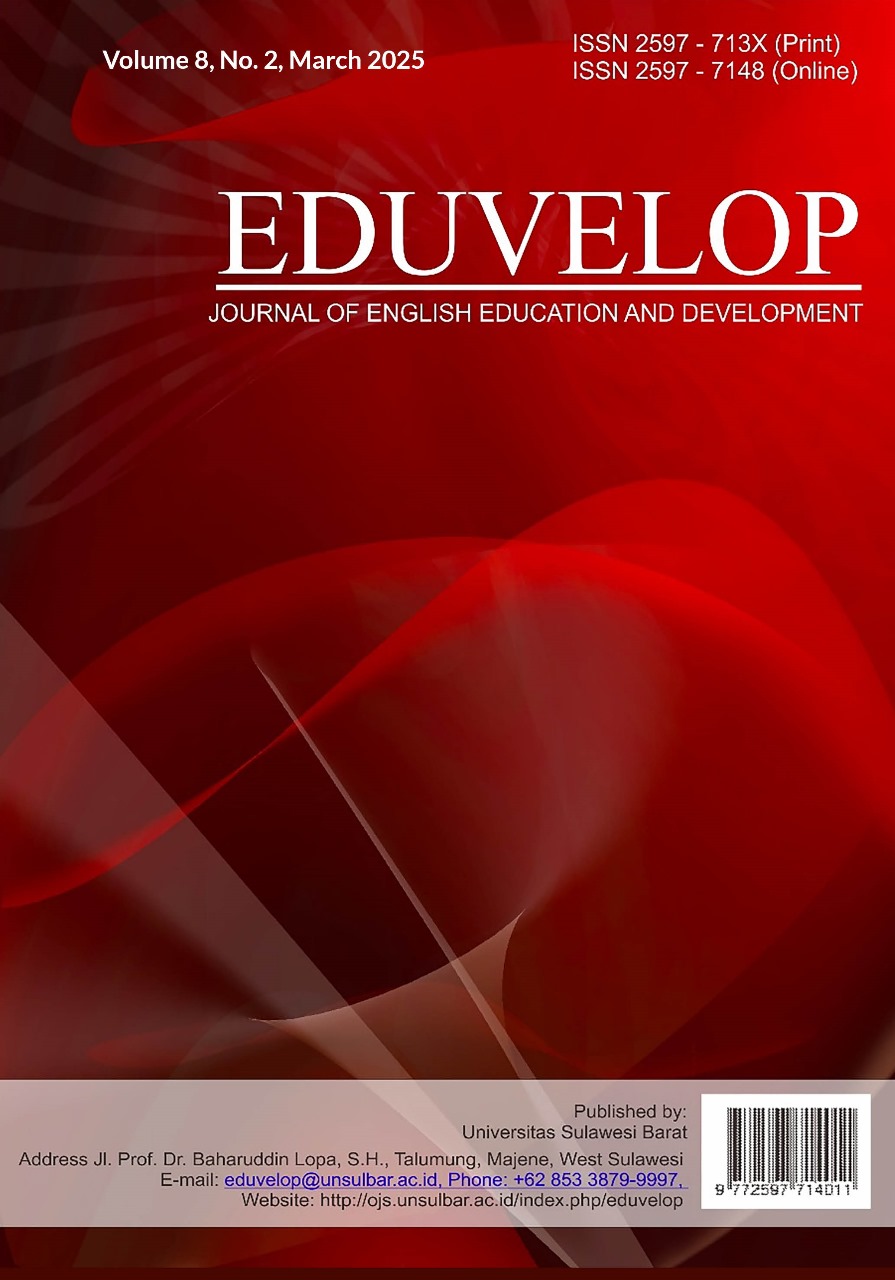Main Article Content
Abstract
This study examines the use of code-switching by lecturers in the TOEFL ITP preparation class. This class is mandatory for students of Siliwangi University to prepare to meet the graduation requirements. Code Switching is a strategy used to practice switching between two languages in communication. The main function of this strategy is also a pedagogical goal. The study aims to analyze the types of code switching, their use and pedagogical goals. The theories used in this study include pedagogical goals, socio-linguistics and the needs and functions of language learning. The research method used is a quantitative method with survey data collection techniques to analyze simple regression of the relationship between lecturer's code-switching and grammatical understanding in TOEFL Preparation. The research was conducted in the political science department of Siliwangi University. The results of the study showed that there was an influence of 83.2% between the code switching variable and the ability to understand grammar in students majoring in political science at Siliwangi University. Therefore, the hypothesis can be accepted. The code-switching strategies used based on the results of the study include inter-sentential code-switching, intra-sentential code-switching, socio-cultural
Keywords
Article Details

This work is licensed under a Creative Commons Attribution 4.0 International License.
References
- Andi Adisaturrahimi, M., & Reskyani. (2024). SECOND LANGUAGE ACQUISITION: THE IMPLEMENTATION OF CODE SWITCHING IN THE TEACHING PROCESS. The 2nd International Conference on Language Teaching 2024, 1994, 75–84.
- Andriani, E., & Ena, O. T. (2022a). Teacher’s Use of Code-switching Types and Functions in Teaching TOEFL and IELTS Preparation Classes. Pedagogy : Journal of English Language Teaching, 10(2), 153. https://doi.org/10.32332/joelt.v10i2.4379
- Andriani, E., & Ena, O. T. (2022b). Teacher’s Use of Code-switching Types and Functions in Teaching TOEFL and IELTS Preparation Classes. Pedagogy : Journal of English Language Teaching, 10(2), 153. https://doi.org/10.32332/joelt.v10i2.4379
- Bakken, J. P. (2016). General and special education inclusion in an age of change: An introduction. Advances in Special Education, 31, 1–12. https://doi.org/10.1108/S0270-401320160000031001
- Bonyadi, A., Kalvanagh, M. K., & Bonyadi, M. (2021). Teachers’ Perceptions on Code-Switching in EFL Classroom Discourse. Discourse and Communication for Sustainable Education, 12(2), 45–53. https://doi.org/10.2478/dcse-2021-0015
- Fareed, M., Humayun, S., & Akhtar, H. (2016a). English Language Teachers’ Code-switching in Class: ESL Learners’ Perceptions. Journal of Education & Social Sciences, 4(1). https://doi.org/10.20547/jess0411604101
- Fareed, M., Humayun, S., & Akhtar, H. (2016b). English Language Teachers’ Code-switching in Class: ESL Learners’ Perceptions. Journal of Education & Social Sciences, 4(1). https://doi.org/10.20547/jess0411604101
- Fauzan Nugraha, I. (2019a). Students’ Perception on The Use of Code-Switching in English Classroom. PROJECT, 2(2).
- Fauzan Nugraha, I. (2019b). Students’ Perception on The Use of Code-Switching in English Classroom. PROJECT, 2(2).
- Golubovich, J., Tolentino, F., & Papageorgiou, S. (2018). Examining the Applications and Opinions of the TOEFL ITP® Assessment Series Test Scores in Three Countries. ETS Research Report Series, 2018(1), 1–30. https://doi.org/10.1002/ets2.12231
- Gumperz, J. J. (1982). Discourse strategies: Studies in interactional sociolinguistics. Cambridge University Press.
- Hall, J. K., Cheng, A., & Carlson, M. T. (2006). Reconceptualizing multicompetence as a theory of language knowledge. In Applied Linguistics (Vol. 27, Issue 2, pp. 220–240). https://doi.org/10.1093/applin/aml013
- Jiang, S., Ma, L., & Chen, B. (2023). Dynamic engagement of cognitive control in intra-sentential code-switching during comprehension. Bilingualism, 26(1), 62–77. https://doi.org/10.1017/S1366728922000323
- Jogulu, L. N., & Radzi, N. S. M. (2018). Code Switching as A Learning Strategy in Polytechnic ESL Classroom: Exploring Perceived Functions and Lecturers-Students’ Attitudes. In International Journal of Education, Psychology and Counseling (Vol. 3, Issue 12).
- Luo, Y. (2019). Chinese University Students’ Perceptions of teacher Code-switching in EFL Speaking Classrooms. English Language Teaching, 12(11), 119. https://doi.org/10.5539/elt.v12n11p119
- Macaro, E., Guo, T., Chen, H., & Tian, L. (2009). Can differential processing of L2 vocabulary inform the debate on teacher code-switching behaviour? The case of chinese learners of english. In Vocabulary Studies in First and Second Language Acquisition: The Interface Between Theory and Application (pp. 125–146). https://doi.org/10.1057/9780230242258
- Macaro, E., & Lee, J. H. (2013). Teacher language background, codeswitching, and English-only instruction: Does age make a difference to learners’ attitudes? TESOL Quarterly, 47(4), 717–742. https://doi.org/10.1002/tesq.74
- Nashruddin, N., Aisyah, S., Syam, U. K., Maros, U. M., & Makassar, U. M. (2024). The use of code-switching by the English teacher in teaching-learning activities. Ilmu Budaya, 8(2), 133–144.
- Nilep, C. (2006). “ Code Switching ” in Sociocultural Linguistics. Colorado Research in Linguistics, 19(June), 1–22.
- Nurhamidah, N., Fauziati, E., & Supriyadi, S. (2018). CODE-SWITCHING IN EFL CLASSROOM: IS IT GOOD OR BAD? Journal of English Education, 3(2), 78–88. https://doi.org/10.31327/jee.v3i2.861
- Park, M. S. (2013). Code-switching and Translanguaging: Potential Functions in Multilingual Classrooms. TESOL & Applied Linguistics, 13(2), 50–52.
- Patmasari, A., & Kamaruddin, A. (2022). An Investigation of the Use of Code-Switching in EFL Classroom: Attitudes and Perceptions. ELS Journal on Interdisciplinary Studies in Humanities, 5, 2022. https://doi.org/10.34050/elsjish.v5i2.21006
- Poplack, S., Sankoff, D., & Miller, C. (1988a). The social correlates and linguistic processes of lexical borrowing and assimilation*.
- Poplack, S., Sankoff, D., & Miller, C. (1988b). The social correlates and linguistic processes of lexical borrowing and assimilation*.
- Sert, O. (2001). The Functions of Code Switching in ELT Classrooms. The Internet TESL Journal The.
- Sert, O., & Amri, M. (2021). Learning Potentials Afforded by a Film in Task-Based Language Classroom Interactions. Modern Language Journal, 105, 126–141. https://doi.org/10.1111/modl.12684
- Setiawan, B. (2023). Code-Mixing vs Code-Switching: a Study of Grammatical Perspective Through Code-Switching Varieties. KnE Social Sciences, 2023, 47–57. https://doi.org/10.18502/kss.v8i7.13235
- Turnbull, M. (2001). There is a role for the L1 in second and foreign language teaching, but. Canadian Modern Language Review, 57(4). https://doi.org/10.3138/cmlr.57.4.531
- Wang, Y. (2019). Wang 1 The Electronic Journal for English as a Second Language (Vol. 3, Issue 3).
- Weinreich, U. (1953). Languages in contact. Linguistic Circle of New York Publication.

